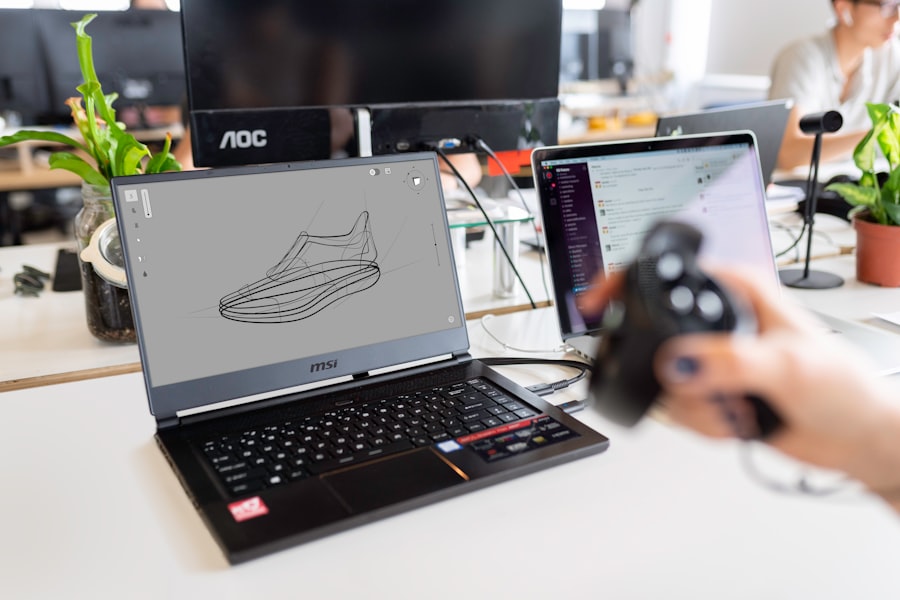In the contemporary landscape of athletics, the integration of technology into sports training has become a pivotal element in enhancing performance and optimizing training regimens. Sports training technology encompasses a wide array of tools, methodologies, and innovations designed to improve athletes’ physical capabilities, mental resilience, and overall performance. From wearable devices that monitor physiological metrics to sophisticated software that analyzes performance data, the technological advancements in this field are reshaping how athletes prepare for competition.
This transformation is not merely about adopting new gadgets; it represents a fundamental shift in the philosophy of training, where data-driven insights and real-time feedback are becoming the norm. The significance of sports training technology extends beyond individual athletes; it influences coaching strategies, team dynamics, and even the business models of sports organizations. Coaches now have access to a wealth of information that allows them to tailor training programs to the specific needs of each athlete, thereby maximizing their potential.
Furthermore, as technology continues to evolve, it opens up new avenues for research and development in sports science, leading to innovative training techniques that were previously unimaginable. This article delves into the evolution of technology in sports training, its impact on athlete performance, and the cutting-edge tools that are currently shaping the future of athletic preparation.
Key Takeaways
- Sports training technology has revolutionized the way athletes train and perform, providing innovative tools and equipment to enhance their performance.
- The evolution of technology in sports training has seen a shift from traditional methods to advanced tools such as wearable devices, virtual reality, and data analysis.
- Technology has had a significant impact on athlete performance, allowing for more precise monitoring, analysis, and optimization of training programs.
- Cutting-edge tools and equipment in sports training include wearable sensors, smart equipment, and advanced training facilities to improve athlete performance and reduce the risk of injury.
- Data analysis and performance tracking play a crucial role in sports training, providing valuable insights into an athlete’s strengths, weaknesses, and areas for improvement.
The Evolution of Technology in Sports Training
The journey of technology in sports training can be traced back to the early 20th century when rudimentary tools such as stopwatches and measuring tapes were employed to assess athletic performance. However, the real revolution began in the latter half of the century with the advent of electronic timing systems and video analysis. These innovations allowed coaches and athletes to capture performance metrics with unprecedented accuracy, paving the way for more scientific approaches to training.
The introduction of heart rate monitors in the 1980s marked a significant milestone, enabling athletes to monitor their cardiovascular responses during training sessions and adjust their efforts accordingly. As we moved into the 21st century, the proliferation of digital technology brought about a seismic shift in sports training methodologies. The emergence of GPS tracking systems allowed for precise monitoring of an athlete’s movement patterns during practice and competition.
This capability not only enhanced performance analysis but also contributed to injury prevention by identifying overtraining or improper biomechanics. Additionally, advancements in biomechanics and motion capture technology have enabled researchers to study athletic movements in detail, leading to improved techniques and reduced injury risks. The evolution of technology in sports training is characterized by an ongoing quest for precision and efficiency, with each new development building upon the successes and lessons learned from previous innovations.
The Impact of Technology on Athlete Performance

The impact of technology on athlete performance is profound and multifaceted. One of the most significant benefits is the ability to gather and analyze vast amounts of data related to an athlete’s physical condition, training load, and performance outcomes. This data-driven approach allows coaches to make informed decisions about training regimens, recovery protocols, and competition strategies.
For instance, wearable devices equipped with sensors can track metrics such as heart rate variability, sleep patterns, and muscle fatigue levels. By analyzing this data, coaches can tailor training programs that optimize performance while minimizing the risk of injury. Moreover, technology has revolutionized the way athletes prepare mentally for competition.
Tools such as biofeedback devices help athletes develop greater awareness of their physiological responses during high-pressure situations. This heightened awareness can lead to improved focus and composure during competitions. Additionally, video analysis software enables athletes to review their performances in detail, identifying areas for improvement and refining techniques.
The combination of physical and mental enhancements facilitated by technology creates a holistic approach to athlete development that was previously unattainable.
Cutting-Edge Tools and Equipment in Sports Training
| Tool/Equipment | Use | Benefits |
|---|---|---|
| High-speed cameras | Analysis of athlete’s movements | Identify areas for improvement |
| GPS trackers | Monitoring athlete’s performance | Optimize training and prevent injuries |
| Cryotherapy chambers | Recovery after intense workouts | Reduce muscle soreness and inflammation |
| Virtual reality simulators | Mental training and visualization | Enhance decision-making and reaction time |
The landscape of sports training is replete with cutting-edge tools and equipment that are transforming how athletes train and compete. One notable example is the use of smart wearables, which include fitness trackers, smartwatches, and specialized clothing embedded with sensors. These devices provide real-time feedback on various physiological parameters such as heart rate, calorie expenditure, and even hydration levels.
Athletes can use this information to adjust their training intensity on-the-fly, ensuring they are working within optimal zones for performance enhancement. Another groundbreaking innovation is the use of advanced simulation technologies in training environments. For instance, augmented reality (AR) systems allow athletes to engage in immersive training experiences that replicate real-game scenarios without the physical demands of traditional practice.
This technology not only enhances skill acquisition but also helps athletes develop tactical awareness by simulating complex game situations. Furthermore, equipment such as resistance bands with integrated sensors can provide immediate feedback on strength training exercises, allowing athletes to optimize their workouts based on real-time data.
Data Analysis and Performance Tracking in Sports Training
Data analysis has emerged as a cornerstone of modern sports training methodologies. The ability to collect and interpret performance data enables coaches and athletes to make evidence-based decisions that enhance training effectiveness. Advanced analytics platforms aggregate data from various sources—such as wearables, video footage, and GPS tracking—to provide comprehensive insights into an athlete’s performance trends over time.
This level of analysis allows for personalized training plans that cater to an athlete’s unique strengths and weaknesses. Performance tracking systems have also evolved significantly, with cloud-based solutions enabling seamless data sharing among coaches, athletes, and support staff. This collaborative approach fosters a culture of continuous improvement where feedback loops are established between training sessions and competitions.
For example, a soccer team might utilize a combination of GPS tracking data and video analysis to assess player movements during matches. By identifying patterns in player positioning or fatigue levels, coaches can make strategic adjustments that enhance team performance during critical moments.
Virtual Reality and Simulation in Sports Training

Virtual reality (VR) has emerged as a transformative tool in sports training, offering athletes immersive experiences that enhance skill development and mental preparation. VR technology allows athletes to practice specific scenarios in a controlled environment without the physical strain associated with traditional training methods. For instance, quarterbacks in American football can use VR simulations to practice reading defenses and making split-second decisions without the risk of injury during physical drills.
The application of VR extends beyond skill acquisition; it also plays a crucial role in mental conditioning. Athletes can engage in visualization exercises within virtual environments that replicate high-pressure situations they may encounter during competitions. This practice helps build mental resilience by allowing athletes to experience stressors in a safe setting while developing coping strategies for real-world scenarios.
As VR technology continues to advance, its potential applications in sports training are likely to expand further, offering new avenues for enhancing athletic performance.
The Future of Sports Training Technology
Looking ahead, the future of sports training technology promises even more groundbreaking innovations that will redefine how athletes prepare for competition. One area poised for significant growth is artificial intelligence (AI) integration into training programs. AI algorithms can analyze vast datasets at unprecedented speeds, identifying patterns that human coaches may overlook.
This capability could lead to more precise predictions regarding an athlete’s performance trajectory or injury risk based on historical data. Additionally, advancements in biotechnology may revolutionize athlete monitoring through personalized nutrition plans tailored to individual metabolic responses. Wearable devices could evolve to include advanced biomarker analysis capabilities that provide insights into an athlete’s nutritional needs in real-time.
Such developments would enable athletes to optimize their diets for peak performance while minimizing recovery times.
Challenges and Ethical Considerations in Sports Training Technology
Despite the myriad benefits associated with sports training technology, several challenges and ethical considerations must be addressed as this field continues to evolve. One significant concern is data privacy; as athletes increasingly rely on wearable devices that collect sensitive health information, safeguarding this data becomes paramount. Organizations must establish robust protocols to ensure that personal information is protected from unauthorized access or misuse.
Moreover, there is an ongoing debate regarding the potential for technology to create disparities among athletes based on access to resources. While elite athletes may benefit from cutting-edge tools and personalized coaching supported by advanced analytics, amateur or underfunded athletes may lack similar opportunities. This disparity raises questions about equity within sports training environments and highlights the need for inclusive practices that ensure all athletes have access to essential resources.
In conclusion, while sports training technology offers remarkable advancements that enhance athletic performance and optimize training methodologies, it is crucial for stakeholders within the sports community to navigate these challenges thoughtfully. By prioritizing ethical considerations alongside technological innovation, we can foster an environment where all athletes can thrive while benefiting from the latest advancements in sports science.
FAQs
What is technology in sports training?
Technology in sports training refers to the use of various technological tools and devices to enhance the performance, skill development, and overall training of athletes. This can include wearable fitness trackers, video analysis software, virtual reality training, and more.
How does technology benefit sports training?
Technology in sports training can benefit athletes by providing real-time feedback on performance, enabling more precise and personalized training programs, and helping to prevent injuries through data analysis. It can also enhance the overall training experience and motivation for athletes.
What are some examples of technology used in sports training?
Examples of technology used in sports training include wearable fitness trackers, such as heart rate monitors and GPS devices, video analysis software for technique improvement, virtual reality training for mental preparation, and performance monitoring systems for data analysis.
How has technology changed sports training in recent years?
In recent years, technology has revolutionized sports training by providing athletes and coaches with access to advanced tools for performance analysis, injury prevention, and personalized training programs. This has led to more efficient and effective training methods.
What are the potential drawbacks of using technology in sports training?
Potential drawbacks of using technology in sports training include the high cost of some advanced equipment, the risk of over-reliance on technology over traditional coaching methods, and concerns about data privacy and security. It is important to use technology as a supplement to, rather than a replacement for, traditional coaching methods.
